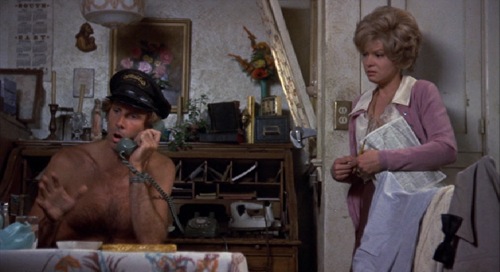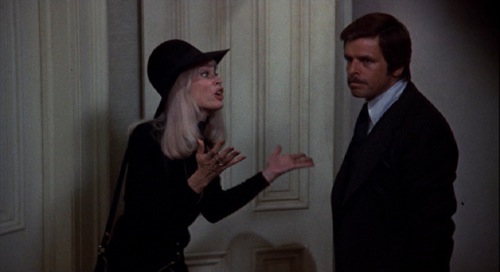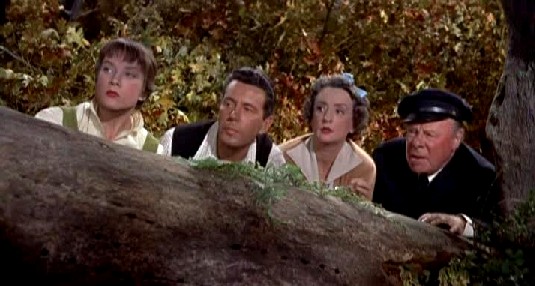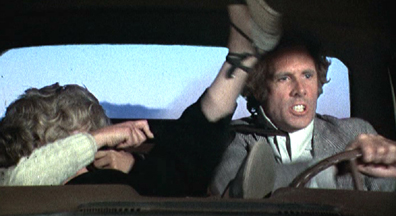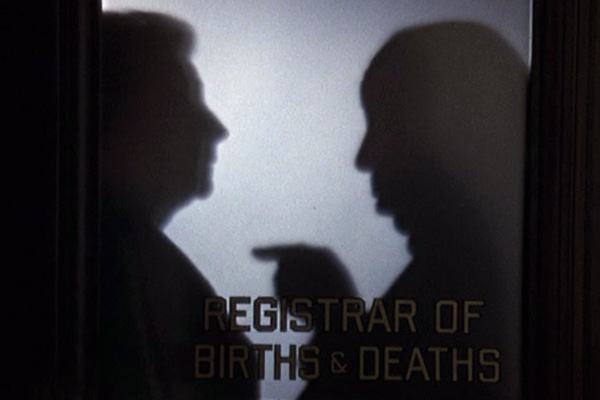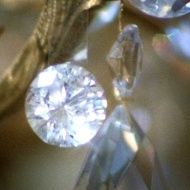I still seem to be in a minority in preferring Family Plot to Alfred Hitchcock’s other late films, but after reseeing the film countless times, I’m not about to revise my opinion. It would appear that some of Hitchcock’s biggest champions, such as Robin Wood, have tended to dismiss the film because it isn’t sicker. I tried to respond to their criticism at least provisionally in the opening of this review, written for the summer 1976 Sight and Sound, which they ran as their cover story for that issue and which I’ve revised, but only minimally. — J.R.
Family Plot
“Everything’s perverted in a different way,” Hitchcock has noted; and perhaps no other filmmaker has illustrated this postulate better, by starting from precisely the opposite premise. Without a well-established sense of the normal, the abnormal doesn’t even stand a chance of being recognized, and the director has always made it his business to offer all the right signposts and comforts to guarantee complacency before proceeding to unhinge it. Yet one of the rules of the game is deception, and if the Master’s artistry has been identified more with rude shocks than with the subtler conditioning which makes them possible, one can be certain that this too plays a role in his overall strategies. Since Psycho in 1960, his public image has largely been construed as a relish for nastiness that invariably associates violent death with the stylish flourish, the director’s “touch” with the grandstanding set-piece -–a tendency culminating in the rape-murders and potato-sack maneuvers in Frenzy.
If in fact the public equation of Hitchcock with mayhem has established its own form of complacency, one of the triumphs of Family Plot is to turn this cherished notion — along with several others — squarely on its head. A marvelously fluid light comedy with scarcely a slack moment, it blithely omits murder entirely, and its only death — of a secondary villain — pointedly occurs off-screen. In striking contrast to the sour distaste expressed for food, sex, and practically all the characters in Frenzy, the mood could hardly be more benign; and with explicitness systematically transposed from a visual to a verbal plane, practically every relationship in the film carries a pronounced erotic undercurrent.
Grasping after precedents, even most of the film’s champions have labeled it only a minor achievement, commonly tracing its virtues back to The Trouble with Harry and regarding it as a kind of septuagenarian’s garden sport. But apart fromn a certain echo of Shirley MacLaine’s delicious kookiness in Barbara Harris’ performance, and an uncharacteristic excellence in the acting throughout, it could be argued that the earlier comedy (one of Hitchcock’s personal favorites) has more importance in his work than is usually admitted, as an oblique commentary on -– and critique of –- his more “official” classics. And within this context, Family Plot can be seen as a veritable testament -– a measured assessment by the director of his methods that, by evaluating which is and isn’t essential to them, clarifies everything in his career preceding it. A central clue to this enterprise is offered by the film’s working title, Deceit; its climactic expression is Barbara Harris’ wink to the audience in the final shot.
The main title credits grow out of shimmering green shapes in a crystal ball while strings and a heavenly choir are heard off-screen; then the face of Blanche (Harris) appear inside the ball, and we find ourselves present at a fake séance -– Blanche intermittently speaking in the male voice of her other-worldly “control” Henry while catering to the needs of Julia Rainbird (Cathleen Nesbitt), a dowager of 78. A brief cut to Blanche peeking between her fingers instantly alerts us to the deception -– a dramatic form of illusion-making not unrelated to Hitchcock’s -– and we soon discover that Rainbird is offering her $10,000 to find her dead sister’s illegitimate son, on whom she wishes to bestow the family fortune. Leaving the house, Blanche steps into a cab driven by her shaggy boyfriend George (Bruce Dern), a self-professed “actor” reduced to hacking who scoffs at her references to Henry as though he were real — reminding her of the sleuthing he does to furnish her séances with facts -– before she mentions the $10,000, and alludes to his future “performance” that night on the waterbed. “Tonight,” he promises, “you’re gonna see a standing ovation” –- and there is an abrupt cut to a mysterious blonde in black crossing the street in front of them, literally slicing into the plot at a right angle and thereby preempting the narrative.
The second plot features another couple, another deception: the blonde is Fran, a brunette Karen Black in disguise, collecting a huge diamond as payment for the return of the kidnapped Mr. Constantine, then returning by car with her own boyfriend Arthur (William Devane) to their upper-class house, where they clean up the secret basement chamber recently vacated by Constantine. Sexual references run through their own dialogue: clearly more at ease with crime and violence, Arthur gloatingly remarks that initially danger makes you sick, “then it makes you very, very loving.” As they start upstairs to bed, he coyly alludes to the diamond he’s just hidden, stressing that she’ll have to torture him to find out its location; and as the camera moves into a large closeup of the jewel, hanging from the chandelier, she says that she intends to do just that.
This comprises only the first movement of the film, with a great deal of plot yet to come including the discovery that Arthur, a jeweler who long ago murdered his foster parents, is Rainbird’s long-lost nephew. But already an intriguing double structure is well underway, with diamond echoing crystal ball, each couple counterpointing the other in terms of class and behavior, and allusions to off-screen sex implying in both cases some of the contrasting power relations, with Blanche and Arthur in the dominant roles. (Significantly, the bedrooms of both couples are never even glimpsed.) Further developing a visual/narrative rhyming structure first noted by Truffaut and Godard in Shadow of a Doubt and The Wrong Man respectively, and more recently appropriated by Rivette in the giddy construction of Céline et Julie vont en bateau, Hitchcock creates a rigorous framework for demonstrating that deception and seduction are opposite sides of the same coin, and that every piece of exposition regarding one couple immediately affects our perception of the other. And whether it’s Arthur picking lint off a policeman’s jacket, Fran fixing gourmet meals for the kidnapped victims, or Blanche and George quickly devouring a hamburger supper, the behavioral charm of all four runs agreeably thick.
Thanks to the precision of Ernest Lehman’s script, the movie proceeds like an immaculately polished mechanism that continually bears witness to the fact and wit of its own operations. Eliminating not only murder from his formula (and from the pedestrian Victor Canning novel The Rainbird Pattern, which served as his starting point), Hitchcock has pared down his devices to the point where whole areas of his expertise can be covered in single, functional, shorthand notations. The hilarious gag of a headstone being carved to loud pop music is also an establishing shot into a scene at the caretaker’s office; and just as the ringing of a doorbell at a crucial juncture registers as a terse summary of all his experiments with sound, a few inches of a bishop’s red habit “leaking” out under a car door suffice as a recapitulation of his inventive uses of color. Best of all is a hair-rising sequence with Blanche and George in a car without brakes barreling down a steep mountain road. An ultimate expression of Hitchcock’s storyboard technique — clearly devised at a desk rather than during shooting or editing –- its suspense derives from algebraic essentials, where the purest kind of “musical” variations can be played on the threats of passing cars, culminating in a wonderfully timed procession of motorcyclists.
At the same time, it defines a pivotal moment in relation to our feelings for the heroic couple: a team of dotty bumblers in contrast to the suave elegance of Arthur and Fran –- perpetually embroiled in domestic spats, and usually figuring like seedy, not very bright opportunists as they clumsily follow the trail left by the missing heir –- their absurdities are brought to a head in this moment of crisis, with Blanche nearly strangling George in hysterical efforts to hold her balance and George howling his irritation as he struggles to guide the runaway car. But it is precisely amidst all this low comedy and frenzy that we realize how little we want this crazy, lovable pair to die. When they subsequently emerge undamaged from the wrecked car and he lifts her into his arms, for once the old-fashioned Hollywood cliché has been proudly earned: the romantic couple from such earlier films as The 39 Steps has improbably been resurrected before our very eyes.
And where does Hitchcock himself figure in all this? We glimpse him earlier on, chatting with a woman in his familiar TV silhouette at the Registry of Births and Deaths, in a rural courthouse where George goes to collect a clue; and it might not be too far-fetched to identify him directly with Henry, Blanche’s alleged “control”. Who else is it, after all, who leads Blanche in a mysterious trance up the stairs in Fran and Arthur’s house after the villainous couple have been safely locked away at the end, tracing a bee-line in a long dolly-and-crane shot to the hidden diamond on the chandelier? The films ads declare:” “You must see it twice!”, and sure enough, an earlier clue is dropped in the adjacent garage as to how she theoretically might have discovered the jewel’s whereabouts. Yet the issue of her psychic powers is deliberately left open, and perhaps a more apposite clue is offered by the strings and voices accompanying her trance-like walk — the same music heard during each of her former séances, and the epitome of that Hollywood “mood” music justly famous for its fostering of illusions. But this time we become another one of her clients, along with George. Concluding this sunny tale of sex, money, and death with her wink at the camera, Hitchcock cheerfully acknowledges his full hand ad his trump card in the same play, slyly suggesting that the real question isn’t whether we’ve been deceived but whether we’d like to have been. Either way, his luminous crystal ball provides all the answers.
— Sight and Sound, Summer 1976

